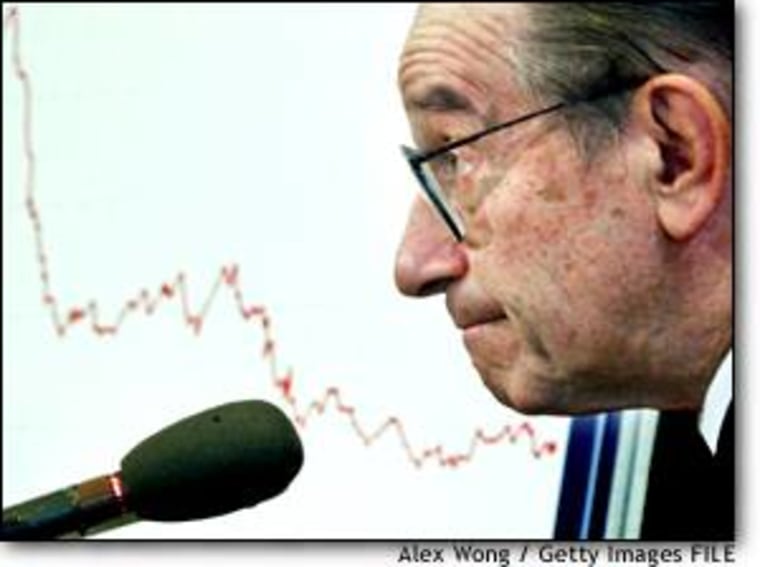Federal Reserve policy-makers Tuesday left short-term interest rates unchanged at their lowest level in more than 40 years, apparently satisfied they have done all they can for now to help the struggling economy through its current “soft spot.”
As expected, Fed Chairman Alan Greenspan and his colleagues left the overnight federal funds rate at 1.25 percent, where it has stood since their last meeting Nov. 6, when they aggressively cut the benchmark by a half-percentage point. The Fed reiterated that members of the policy-making Open Market Committee believe risks are “balanced” given their desire to boost economic growth without reigniting inflation, which is nearly non-existent.
“The limited number of incoming economic indicators since the November meeting, taken together, are not inconsistent with the economy working its way through its current soft spot,” the Fed said in a statement, which was unanimously endorsed by the 12-member committee.
Jan Hatzius, senior economist at Goldman Sachs, called the grammatically tortured comment “about as weak a positive statement as you could possibly make.”
“In their mind not much has changed since the last meeting,” Hatzius said. “The numbers at least have not gotten any worse from October to November. Whether they have gotten genuinely better is a question.”
But Tony Crescenzi, chief bond market strategist for Miller Tabak & Co., said he was encouraged that the Fed eliminated from its previous statement a reference to uncertainty caused in part by “heightened geopolitical risks.”
“The deletion is important because it reinforces the notion that the Fed believes the U.S. is indeed emerging from the recent soft spot and thereby required the subtle shift in policy,” he said in a note.
The Fed now has cut rates 12 times since January 2001, and many analysts believe the central bank is likely to stay on the sidelines for the foreseeable future, with its next move being a rate increase.
“We believe the Fed is done easing and will remain on hold through the end of 2003,” Gerald Cohen, a senior economist at Merrill Lynch, said in a note. “While recent data have been soft, they don’t show a deepening slide. ... Assuming that whatever happens with Iraq doesn’t result in a sizable oil shock, the economy should return to a more satisfying rate of growth in the spring.”
Hatzius said the central bank could cut rates another quarter-point in the next three to six months “if the data deteriorate again.” With deflation considered more of a risk than renewed inflation, Hatzius said the central bank is unlikely to begin raising rates until the fourth quarter.
In any case, with the president replacing his economic leadership team and Republicans taking control of both houses of Congress, Wall Street’s focus is turning away from monetary policy to the likelihood of fiscal stimulus next year.
“I think everybody is looking for a shot in the arm from the federal government in terms of tax cuts and more spending as well,” said Vince Boberski, senior economist at RBC Dain Rauscher. “Especially if we do end up going to war in the Middle East, that’s going to ramp up spending all by itself.”
Financial markets had little reaction to the Fed’s midafternoon announcement. Stock prices ended higher in light trading.
Boberski predicted the economy will recover on its own by mid-2003, boosted by higher spending on business inventories and renewed investment in information technology.
“If we get to that point and we also get a tidal wave of federal money coming through the economy it’s going to exaggerate the recovery and potentially put some pressure on prices,” he said.
The unemployment rate rose surprisingly to 6 percent in November from 5.7 percent in October, the government said last week in the latest sign of sluggish growth. The manufacturing sector in particular has been weaker than in expected, while the housing market has remained strong, buoyed by low interest rates.
Given the recent mixed data, many analysts are pinning their hopes on the current holiday shopping season, which is expected to show modest growth over last year’s sales levels.
Fed's full statement
The Fed issued the following statement after its Tuesday meeting:
“The Federal Open Market Committee decided today to keep its target for the federal funds rate unchanged at 1-1/4 percent.
The Committee continues to believe that this accommodative stance of monetary policy, coupled with still robust underlying growth in productivity, is providing important ongoing support to economic activity. The limited number of incoming economic indicators since the November meeting, taken together, are not inconsistent with the economy working its way through its current soft spot.
In these circumstances, the Committee believes that, against the background of its long-run goals of price stability and sustainable economic growth and of the information currently available, the risks are balanced with respect to the prospects for both goals for the foreseeable future.
Voting for the FOMC monetary policy action were Alan Greenspan, Chairman; William J. McDonough, Vice Chairman; Ben S. Bernanke, Susan S. Bies; Roger W. Ferguson, Jr.; Edward M. Gramlich; Jerry L. Jordan; Donald L. Kohn, Robert D. McTeer, Jr.; Mark W. Olson; Anthony M. Santomero, and Gary H. Stern.”
